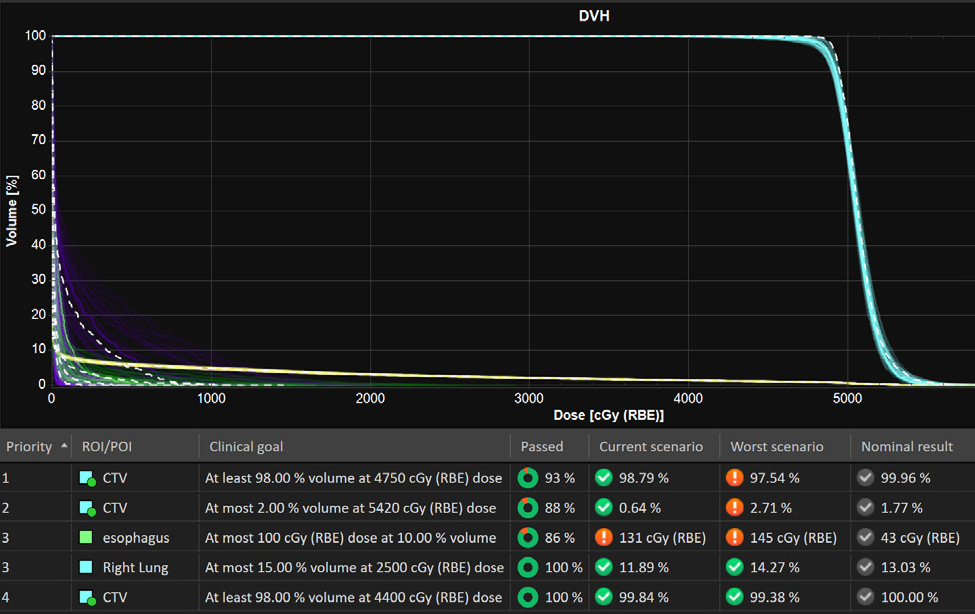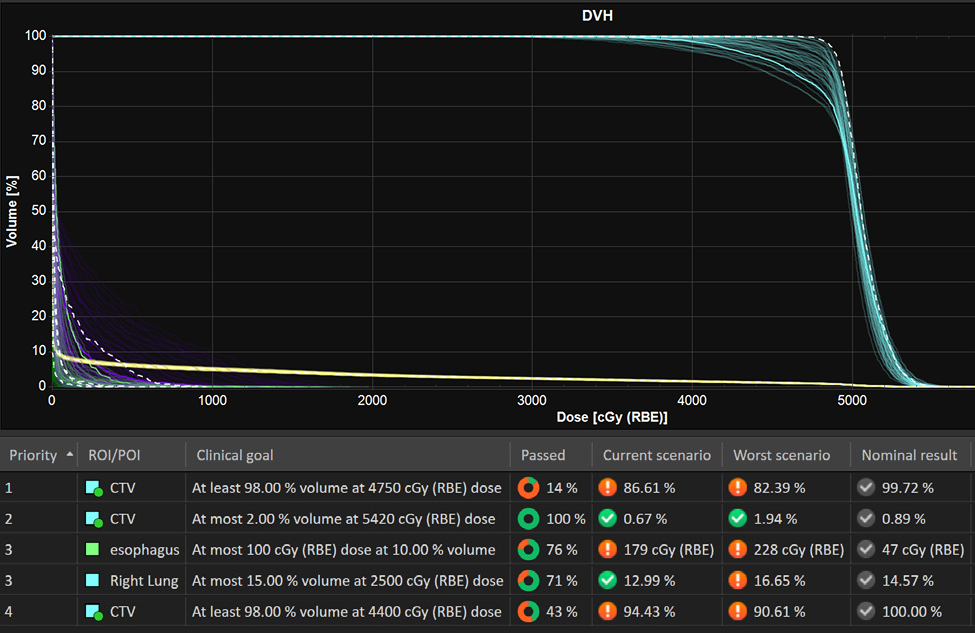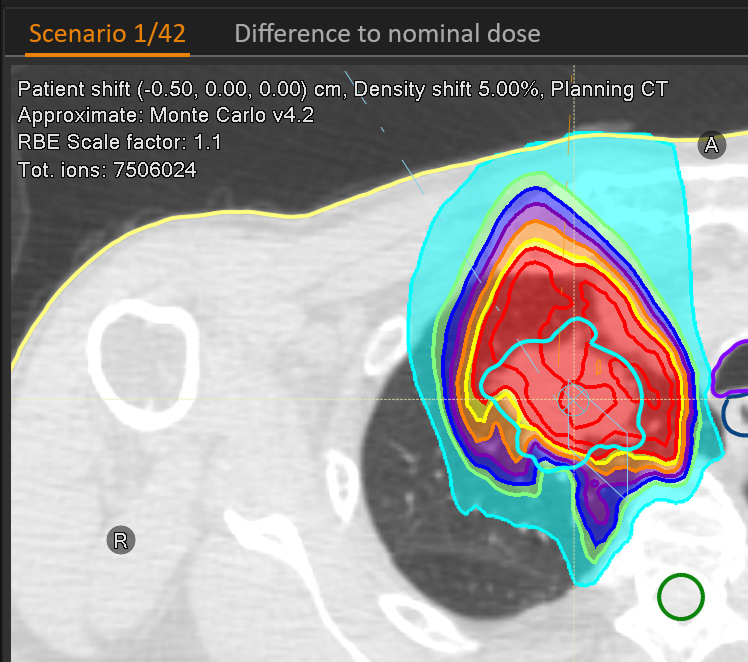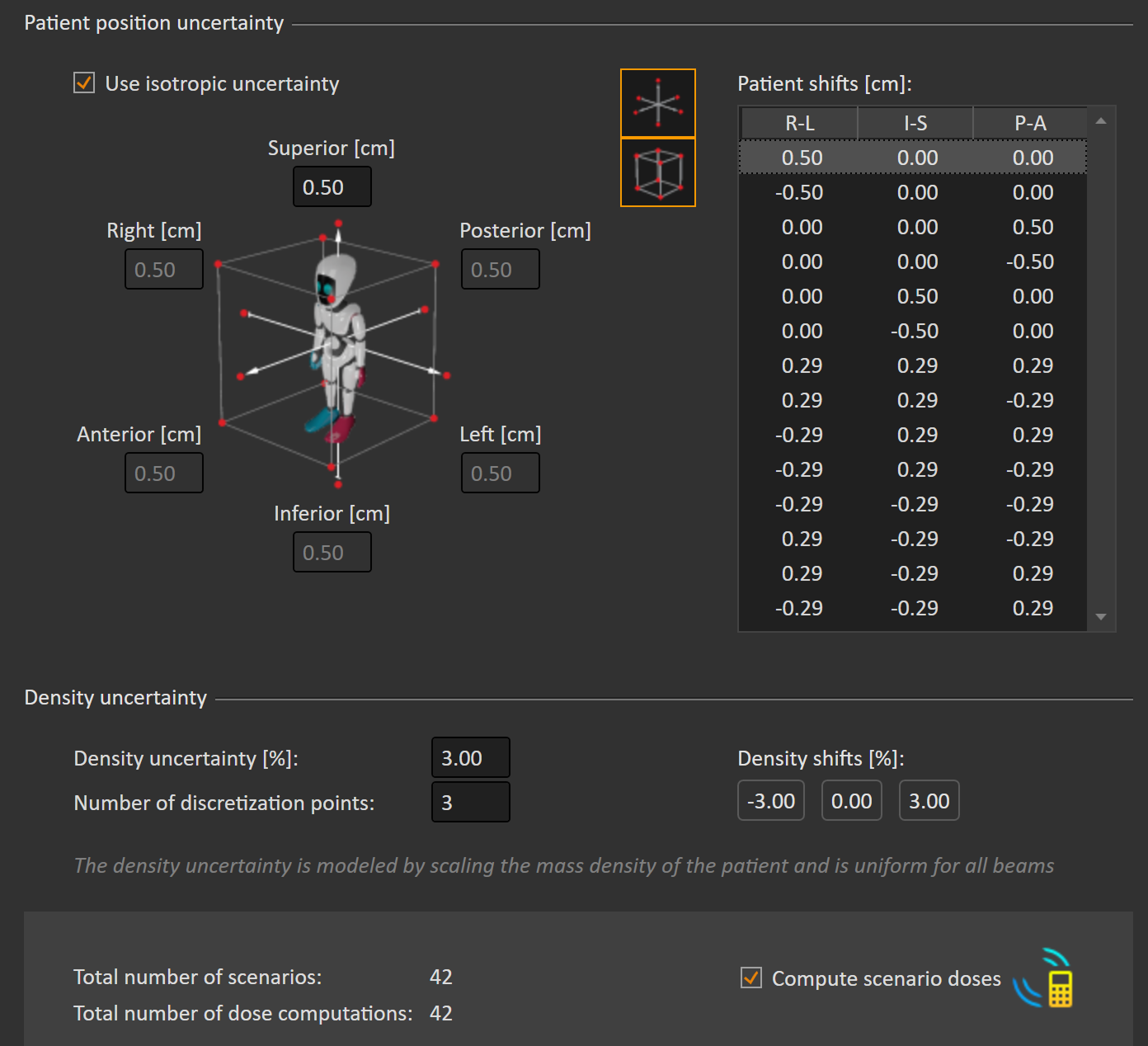
EVALUATION OF ROBUSTNESS IN RAYSTATION
Robustness evaluation should be an integral part of any treatment planning process to assess the capability of the plan to deal with uncertainties. The Robust evaluation module in RayStation enables simultaneous evaluation of a large number of possible error scenarios and provides versatile tools for detailed analysis of the plan robustness. The current version supports setup and density uncertainties, which are combined to create a group of scenarios.
SIMULTANEOUS EVALUATION
The Robust evaluation module in RayStation makes it possible to simultaneously evaluate all chosen scenarios. This can be achieved by the use of dose-volume-histograms (DVHs), clinical goals and display of dose distributions in the patient views.
DVH CLUSTER
In the treatment planning process, DVHs are commonly used to assess the quality of the treatment plan. When evaluating the plan with respect to robustness, many different perturbation scenarios could potentially occur, and all DVHs are equally interesting to investigate. In the DVH cluster of the Robust evaluation module all scenario DVHs, as well as the nominal plan DVH, are displayed in the same graph. This makes it easy to get an overview of all scenarios at the same time: if all scenario DVHs are close to the nominal DVH (Figure 1, left), the plan is robust with respect to the evaluated parameters. On the other hand, if large deviations are observed with e.g. cold and hot spots in many of the evaluated scenarios (Figure 1, right), the plan is non-robust. For more in-depth analysis of a specific scenario, it can easily be selected by clicking on the corresponding DVH.
CLINICAL GOALS
The clinical goals used for planning are also displayed in the Robust evaluation module. However, in this module there are additional columns showing e.g. the percentage of scenarios passing a specific clinical goal. The value of the clinical goal for the currently selected scenario, as well as for the worst-case scenario with respect to that clinical goal, are also displayed. By clicking on the worst-case clinical goal value, the corresponding scenario is directly selected.
3D DOSE DISTRIBUTIONS
For a more detailed analysis of a specific scenario, the dose distribution can be displayed in the patient views. Additionally, it is possible to get a side-by-side comparison to the nominal dose distribution, as well as a dose difference to the nominal plan. Using the concepts of voxel-wise minimum and maximum, simultaneous evaluation over all scenarios is enabled also for the dose distributions. In these modes, the minimum (maximum) dose in each voxel evaluated over all scenarios is retrieved to construct a new dose distribution, which can be displayed in the patient views. In these modes, the voxel-wise worst value is also displayed for each clinical goal. The concept of voxelwise minimum and maximum dose distributions and clinical goals has been extensively evaluated by the proton centers in the Netherlands and has been shown to create a direct link to previous experience with PTV-based evaluation for photons [1]. This approach will be used in clinical practice by these centers when a PTV is not used, e.g. for robustly optimized proton or photon plans.




CREATION OF SCENARIO GROUPS
The scenario groups are easily created for different uncertainty settings with respect to patient setup and density inter pretation errors. As can be seen in Figure 3, the patient setup error can be specified in the main directions (Posterior-Anterior, Right-Left, Inferior-Superior), and the resulting error scenarios are retrieved from these values. Density errors are specified as a percentage, p, combined with the number of discretization points in the range [-p, p].

The total number of scenarios equals the product of the number of patient setup uncertainties and the number of density shifts. For each of the scenarios, a dose computation is required. However, if the evaluation dose has already been computed in another scenario group, it can be reused in the current scenario group without a new dose computation.For an even more flexible definition of scenarios, the position uncertainty can be specified as a list of shifts through the RayStation scripting interface. All other options in the graphical user interface are scriptable to allow for automated creation of one or several scenario groups after the treatment plan has been created.
OUTLOOK
In the longer term, more possibilities to create error scenarios will be added to the Robust evaluation module, allowing for a large variety of different evaluations. Examples include evaluation on multiple image sets and interplay effect eva-luation for modulated phoon and ion plans. However, evenfor the most complex evaluation setups, the evaluation metrics with DVH clusters, scenario group clinical goals and dose distributions will remain the same, providing a fast assessment of the robustness of the plan irrespective of the underlying uncertainty settings.
REFERENCES
[1] E.W. Korevaar et al. Practical robustness evaluation in radiotherapy – A photon and proton-proof alternative to PTV-based plan evaluation, Radiother Oncol (submitted), 2019
* Subject to regulatory clearance in some markets.
For more information or to see a demo, contact sales@raysearchlabs.com